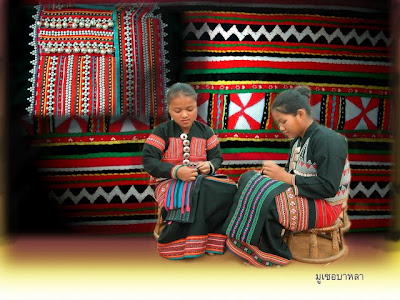Population: There are 43 know villages of Lawa, which number some 300 or more households, averaging about 30 house per village, and 7.0 persons per house. The total papulation is estimated at 9,000persons(this my be a low estimate). The largest village is Baw Luang, in which there are 230 households. Few Lawa villages number less than 25 houses.  Language : As outlined above, the Lawa speak a language related to Wa, and use many of the same words. The author does not feel that this is one of the Mon-Khmer language, nor is there anything more than remote Mon-Khmer influences, if any, in this language. It is a language, together with Wa, which perhaps deserves a separate classification. There are no clear indications to show linguistic influences which the Mon invaders of the 6th and 7th century A.D. might have had on the Lawa people. Today, most of the Lawa are able to speak Lao-Thai fluently, Those Lawa, found on the Baw Luang plateau, and nearer to Mae Sariang, have been in close contact with the Thai people, so that many of younger people have been Thai schools. While some of them are literate in Thai, few of them speak Thai well, preferring the northern(Lao-Thai) dialect. There are individuals who can speak Skaw Karen well, or have good understanding of it. They speak no other language, and have no written language of their own.
Language : As outlined above, the Lawa speak a language related to Wa, and use many of the same words. The author does not feel that this is one of the Mon-Khmer language, nor is there anything more than remote Mon-Khmer influences, if any, in this language. It is a language, together with Wa, which perhaps deserves a separate classification. There are no clear indications to show linguistic influences which the Mon invaders of the 6th and 7th century A.D. might have had on the Lawa people. Today, most of the Lawa are able to speak Lao-Thai fluently, Those Lawa, found on the Baw Luang plateau, and nearer to Mae Sariang, have been in close contact with the Thai people, so that many of younger people have been Thai schools. While some of them are literate in Thai, few of them speak Thai well, preferring the northern(Lao-Thai) dialect. There are individuals who can speak Skaw Karen well, or have good understanding of it. They speak no other language, and have no written language of their own.
 rmed by many households coming from different places. In general, the headman is responsible for maintaining the peace, settling disputes, hosting visitors to the village and also action as the village liaison with government authorities. In a mature village, there is usually an informal council of elders whose advice is sought on important issues by the headman. This council participates in the making of all important decisions which affect the village. Typical issues include whether the village should be moved to a new site or not, whether outsiders should be allowed to cut swiddens on village land, or whether a particular household should be expelled.
rmed by many households coming from different places. In general, the headman is responsible for maintaining the peace, settling disputes, hosting visitors to the village and also action as the village liaison with government authorities. In a mature village, there is usually an informal council of elders whose advice is sought on important issues by the headman. This council participates in the making of all important decisions which affect the village. Typical issues include whether the village should be moved to a new site or not, whether outsiders should be allowed to cut swiddens on village land, or whether a particular household should be expelled. and spirits in certain things. These spirits, either benevolent or malevolent, usually require propitiation and sacrifice and for some tribes, their highest and most respected spirits are godlike. Many cases of sickness are believed to be caused by offended spirits, especially the evil ones. These spirits are considered to have cast bad fortune on the individual or group concerned by taking away their souls, causing sickness and harming their livestock. Either the shaman or the religious leader must diagnose the cause of sickness. The benevolent spirits are requested to come and are provided with offerings in return for force the evil ones to return the soul to the sick person. However, many spirits can be either benevolent or malevolent depending on whether or not they are treated properly.
and spirits in certain things. These spirits, either benevolent or malevolent, usually require propitiation and sacrifice and for some tribes, their highest and most respected spirits are godlike. Many cases of sickness are believed to be caused by offended spirits, especially the evil ones. These spirits are considered to have cast bad fortune on the individual or group concerned by taking away their souls, causing sickness and harming their livestock. Either the shaman or the religious leader must diagnose the cause of sickness. The benevolent spirits are requested to come and are provided with offerings in return for force the evil ones to return the soul to the sick person. However, many spirits can be either benevolent or malevolent depending on whether or not they are treated properly.

























































